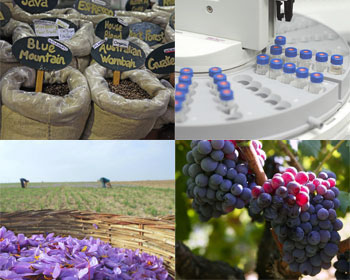A Publication of the
Applied Math and Science Education Repository

The AMSER Science Reader Monthly aims to provide educators with a useful package of information about a particular topic related to applied math and science by combining freely available articles from popular journals with curriculum, learning objects, and web sites from the AMSER portal. The AMSER Science Reader Monthly is free to use in the classroom and educators are encouraged to contact AMSER with suggestions for upcoming issues or comments and concerns at [email protected].
This month's AMSER Science Reader Monthly topic is Food Chemistry.
Food Detectives: Analytical chemists devise methods to confirm foods are what they claim to be
Article by Sophie L. Rovner, Senior Editor from Chemical and Engineering News
Synopsis and resource annotations by Max Grinnell

What's in a loaf of bread? Wheat? Natural flavors? High fructose corn syrup? Or are there other less obvious ingredients? These are the types of questions that analytical chemists pose everyday, and there is a growing concern among the general public about what ingredients various foodstuffs actually claim to contain and what they actually contain.
In the April 5, 2010 edition of Chemical & Engineering News, Sophie L. Rovner reported on this very subject by taking a closer look at the work of chemists who are trying to develop more rigorous analytical methods to authenticate food and wine. In the piece, Rovner talks to chemists working in viticulture, a representative from the Australian Wine Research Institute, and a chemist at the United States Department of Agriculture.
One recent incident that piqued interest in this subject was a lawsuit filed in late February against E & J Gallo, the world's second largest winery. The lawsuit claimed that Gallo and its suppliers sold 18 million bottles of wine labeled as Pinot Noir which "actually contained wine made from cheaper Merlot and Syrah grapes." Gallo has blamed their suppliers, some of whom have been convicted of such fraud in France.
As a result of this and other incidents, a number of researchers have begun the quest to find chemical markers in various foodstuffs that can determine their purity and origination. There are a number of potential roadblocks along the way; it is difficult to establish valid standards to judge the authenticity of a given food sample. It will be necessary over time to compile databases that can include profiles from a range of varieties, production processes, and geographic places of origin.
The piece concludes by offering insights into new techniques using DNA and spectrometry to analyze grape leaves, coffee beans, tea, and saffron. Professor Susan E. Ebeler of the University of California, Davis notes that these various new techniques will help "consumers be much more sure that they're actually getting what they're paying for."
Found below is a list of useful resources that will illuminate and enhance understanding of the topics found within this article. The first link will take users to the Kitchen Chemistry course homepage as offered by MIT's OpenCourseWare Initiative. The site contains instructional videos, a syllabus, and some assignments which explore the world of food chemistry. Moving on, the second link leads to a complete book created by the National Health Museum which deals with food biotechnology. The book also contains instructional units that can be used by students and teachers. The third link will take interested parties to the Fun Food Stuff site, created at the University of Wisconsin Biotechnology Center. Here visitors can take on some interesting food demonstrations, including "Better Bubbles-Skim or Whole?" and "DNA Dance". The fourth link leads to an interesting article and experiment on counting calories, which provides an introduction to food energy and how it is measured. The fifth link leads to the Government Food Safety clearinghouse website. Here visitors can learn about hot dogs and food safety, food safety work in all of the 50 states, and read up on recent food recalls. The final link takes visitors to the Bringing Food Chemistry to Life blog created by Professor Andrew Ross of Oregon State University. Visitors can scroll through his posts to learn about the chemistry of coffee and the world of bread. Overall, these resources should provide greater scope and help contextualize the ideas and concepts found within in the featured work. The list provides links to resource records in the Applied Math and Science Education Repository (http://amser.org/).



